
Overland Tech and Travel
Advice from the world's
most experienced overlanders
tests, reviews, opinion, and more
Accessible wonders

Many years ago, while on an assignment for Outside magazine, I was graced with the incomparable experience of viewing Victoria Falls for the first time by walking up to the edge of the drop on Livingstone Island, right in the middle of the mile-wide cascade, after arriving by canoe, just as David Livingstone had almost exactly 150 years before. The breath literally left me; I gasped and very nearly wept at the sight. Only the terror of totally losing my cool in front of my guide kept me halfway composed.
Much more recently—last week in fact—I was graced with another first: driving out of the tunnel on California State Highway 41, the Wawona Road, and seeing Yosemite Valley spread out before me below sweeping clouds and mist. El Capitan rose on the left in an impossible vertical wall; Bridalveil Fall plunged in a gossamer thread on the right.
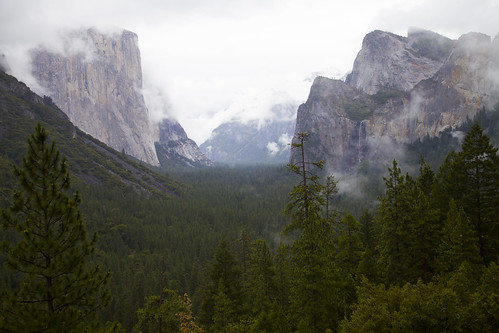
To paraphrase: The breath literally left me; I gasped and very nearly wept at the sight. Only the terror of totally losing my cool in front of my wife kept me halfway composed.
It was a good lesson in something many of us tend to forget: You don’t necessarily need to travel to Zambia (or fill in the blank) to have a once-in-a-lifetime experience. We were two easy day’s drive from home, and the sum total of our off-pavement excursions to that point had been about 500 yards of dirt road to reach a Forest Service dispersed campsite. Yet that view of Yosemite Valley will forever live in my memory directly alongside that first vertiginous peek over Victoria Falls.
The two natural wonders share more than you might think. Both were “discovered”—i.e. sighted for the first time by a person of European stock—in the mid-1800s, after of course being well-known to the locals for ages. In both cases, the “discoverers” were on profit-driven missions: Joseph Walker was looking for furs when he stumbled on Yosemite Valley, and Livingstone hoped to find a water route into the heart of the African continent. Both sites are now overrun with tourists pursuing, at times, tangent activities that seem utterly superfluous to me: I’ve said frequently that if you view Victoria Falls for the first time and think, Okay, cool—now I need to go bungee jumping off the bridge, then there’s something seriously wrong with your sense of wonder.
Yet the grandeur of both places effortlessly transcends the swarms of humans buzzing around them. Even at Yosemite, we found a trail along the Merced River, under El Capitan, on which in four miles we met two other people. And at Victoria Falls I spent a night camped on Livingstone Island (alone except for an askari), and got up at midnight to see the “moonbow”—a rainbow caused by moonlight shining through the mist of the falling water. Later I was awakened by the sound of foraging elephants, which wade to the island at night to feed.
So maybe I shouldn’t complain that everyone else was off bungee jumping.
 The author, alone at dusk on Livingstone Island. The bungee jumpers are off toasting their adventure somewhere.
The author, alone at dusk on Livingstone Island. The bungee jumpers are off toasting their adventure somewhere.
New VDEG imminent . . .
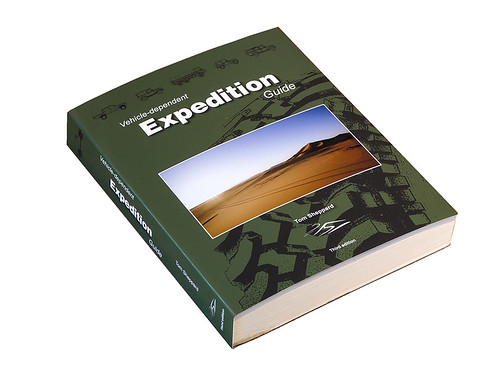
I just received this cryptic note from an unnamed source somewhere in the U.K.:
"Desert Winds Publishing (i.e. Tom Sheppard) is pleased (relieved) to announce to its patient, faithful customers and enquirers – some of whom started the list last July – that VDEG3 (otherwise known as the new, third edition of the 500-page Vehicle-dependent Expedition Guide), has been proofed and should soon be available. At the same price as before (36 GB pounds) – and not through Amazon, or ‘used’ at four times that figure. (Postage: UK £5.85; EU £9.50, elsewhere, inc US, £16.00)
‘Relieved’ because the techno-gremlins chose the 11th hour to attack the layout software, calling on the true spirit, tenacity and ingenuity of overlanders to get things back on track. Desert Winds Customer Service Department (i.e. Tom Sheppard) quotes their Chief Proof Checker (i.e. Tom Sheppard) as saying, ‘Yes, quite a few of the pictures are now the right way up and most of the text has been back-translated from the Indo-Iranian zabani-tadjik calligraphy’.
On stage, smartly dressed in a black turtle-neck, Desert Winds’ CEO (yes … ) thanked the small distinguished army of back-order e-mailers for their patience and asked them to keep an eye on the www.desertwinds.co.uk website which Desert Winds Webmaster (you guessed it … ) will be updating very soon."
 A Desert Winds spokesman, questioned by a lady with a clip-board, said, "No, the actual book won't be as large as the sheets on the table in the foreground."Just in case you've been living under a rock in the Sahara (or are new to the overlanding world, in which case you're forgiven), Tom's Vehicle Dependent Expedition Guide is the bible of overlanding, and a copy should be in the library of anyone remotely interested in vehicle-dependent travel. It is, quite simply, superb in its authority, scope, and humor (i.e. humour), and is the standard by which all other books on the subject are and always will be judged. The fact that it can (and can only) be purchased directly from the writer/publisher/proof checker/customer-service representative is a lovely bonus in this day of Amazon.com facelessness. Of all the high-quality and/or indispensable items I try to discover and recommend on OT&T, you'll thank me for none more than this one. In case you missed the link in the text, it's available HERE.
A Desert Winds spokesman, questioned by a lady with a clip-board, said, "No, the actual book won't be as large as the sheets on the table in the foreground."Just in case you've been living under a rock in the Sahara (or are new to the overlanding world, in which case you're forgiven), Tom's Vehicle Dependent Expedition Guide is the bible of overlanding, and a copy should be in the library of anyone remotely interested in vehicle-dependent travel. It is, quite simply, superb in its authority, scope, and humor (i.e. humour), and is the standard by which all other books on the subject are and always will be judged. The fact that it can (and can only) be purchased directly from the writer/publisher/proof checker/customer-service representative is a lovely bonus in this day of Amazon.com facelessness. Of all the high-quality and/or indispensable items I try to discover and recommend on OT&T, you'll thank me for none more than this one. In case you missed the link in the text, it's available HERE.
A versatile storage box: the Wolf Pack
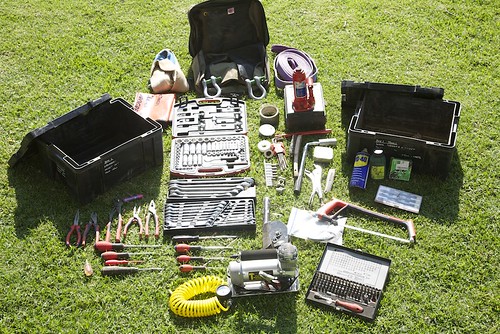 A pair of Wolf Packs holds tools for a Defender 110 in Tanzania.I have yet to meet the perfect overlanding cargo box. Pelican cases are nearly perfect when contents absolutely, positively must be kept dry and dust-free, thus they are the box of choice for, say, photo and video equipment. But Pelican cases are quite heavy for their volume, and pretty expensive for everyday cargo. Zarges (or the similar Alu-Box) aluminum cases are strong, lightweight, and boast excellent interior to exterior volume, but are even more expensive (although you can consider the expense an investment as they last forever with reasonable care).
A pair of Wolf Packs holds tools for a Defender 110 in Tanzania.I have yet to meet the perfect overlanding cargo box. Pelican cases are nearly perfect when contents absolutely, positively must be kept dry and dust-free, thus they are the box of choice for, say, photo and video equipment. But Pelican cases are quite heavy for their volume, and pretty expensive for everyday cargo. Zarges (or the similar Alu-Box) aluminum cases are strong, lightweight, and boast excellent interior to exterior volume, but are even more expensive (although you can consider the expense an investment as they last forever with reasonable care).
But more economical alternatives always have some fatal flaw. The affordable Rubbermaid Action Packers are excellent for home storage, but their volumetric efficiency is abysmal and they leak if rained on, so you can’t leave them outside the vehicle when camped unless they’re under cover. If strapped down too tightly (i.e., properly . . .), they collapse. Lower-priced alternatives are even worse.
Several years ago in Tanzania I discovered the plastic ammunition cases used by the South African military, now commercially produced and known widely as Wolf Packs. They’re moderately sized and so easy to arrange in a cargo bay, completely rainproof and reasonably dustproof, and vertical-sided to avoid wasted space (except for hollow corner pieces). They stack securely for convenient storage at home. The Wolf Packs suffer from poorly designed latches—those familiar with them will call that a hilarious understatement— and the lids flex more than I’d like when called upon to do duty as a step, but otherwise they are sturdy, versatile, and sport a certain exotic flair given their origins. Front Runner Vehicle Outfitters is now a U.S. distributor, and for $40 each you can justify several—trust me, you’ll find uses for all you get. We have six, and just glancing around the shop I can see uses for another six. Or ten.
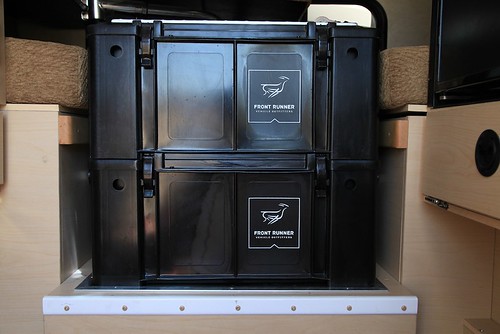
We found that a pair of Wolf Packs stacks and straps down perfectly in the shower grate of the JATAC, under the dinette table. Another rides near the door, and holds all the items we use for pitching camp: drain hose for the galley sink, leveling blocks, guylines and stakes for the awning, etc. I sourced some 1/4-inch thick aluminum diamondplate and fabricated steps for the lids of two of them, attached with small stainless bolts; the three now form a perfect staircase to access the camper when we’re parked.
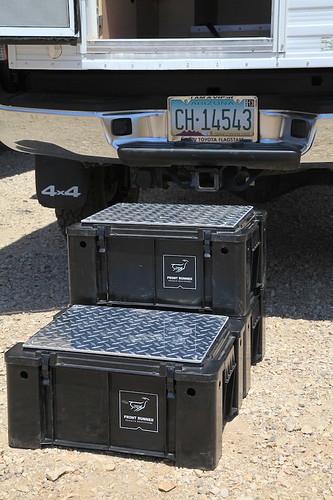
I also keep two in the back of my FJ40. One holds recovery gear; the other contains a small stove and cook kit, water, and other odds and ends to make an emergency camp or an impromptu picnic.
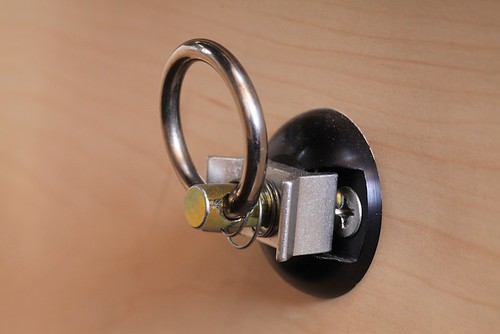 A pair of Mac's Tie-Downs anchor plates and rings, bolted through each side of the dinette seat box, provides anchors for the ratchet strap that secures the boxes.
A pair of Mac's Tie-Downs anchor plates and rings, bolted through each side of the dinette seat box, provides anchors for the ratchet strap that secures the boxes.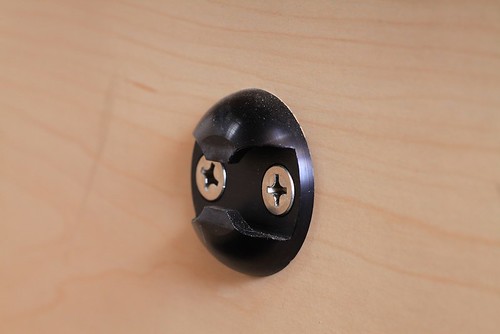 When not needed, the ring detaches instantly.
When not needed, the ring detaches instantly.
Front Runner's website is here. They also sell improved steel latches.
The analog iPhone
 Ready for the bio-apocalypse: a steel-framed handgun and the amazing Pocket Ref
Ready for the bio-apocalypse: a steel-framed handgun and the amazing Pocket Ref
In the speculative-fiction novel Directive 51, author John Barnes postulates an alarmingly plausible near-future in which all plastics, synthetic rubbers, and oil-based fuels have been destroyed by maliciously created self-replicating nanobots and bioengineered microorganisms. All modern communication, transportation, and just about everything else is brought to a halt, and the world is plunged into chaos. The most advanced technology possible peaks at steam engines and vacuum tubes. The book is so believable that Roseann, normally a both-feet-on-the-ground skeptic, mentioned casually after reading it, “You know, it wouldn’t hurt to have a few cases of canned vegetables stored here . . .”
Given our remote home site, dependable well, and abundant wildlife (not to mention free-ranging cattle), we’d be in better shape to survive a bio-apocalypse than 99 percent of the U.S. population. And I feel about 99 percent better equipped to do so since my friend Bruce handed me a copy of Thomas Glover’s Pocket Ref.
I’ve used various one-subject pocket references before (wiring, plumbing), but this tiny 864-page book covers an array of subjects that is simply stunning. Look through the index and pick an uncommon letter—say, W. Now pick one entry out of the 31 listed under W—say, weather. Glover’s Pocket Ref will tell you the following things about weather: Beaufort wind scale; cloud types; cold water survival time; dew points; Fujita-Pearson tornado intensity scale; heat/humidity factors; hurricane intensity scale; ice thickness safety; weather map symbols, and wind chill factors. Over in the Fs, under formulas, you’ll find a staggering 105 entries, from Ohm’s law to antenna length to load on a wire rope or sling to sound intensity to voltage drop vs. wire length, diameter, and current.
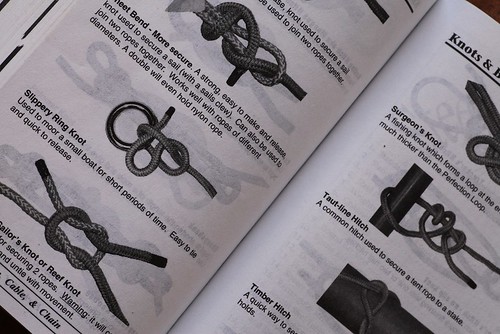 Knots will still work - but better stock up on sisal rope.Other entries: knots—lots of them—treatment for a sucking chest wound; steel tubing specifications; maximum floor joist spans; simple and compound interest factors; area formulas, solvent types; and I could go on for another 863 pages. Need to calculate how much water is left in a cylindrical tank of known diameter and length? No problem. Need to know the rank of the uniformed military personnel who show up after the apocalypse to declare martial law? No problem. Do you have a hard time remembering the geologic time scale (did the Miocene or the Pliocene come first?)—no problem. I can now quickly figure the BTUs available in a cord of Douglas fir, or the clamping force possible with a 15mm 8.8 bolt, or the proper hand signals for a crane and hoist operator. Amazing.
Knots will still work - but better stock up on sisal rope.Other entries: knots—lots of them—treatment for a sucking chest wound; steel tubing specifications; maximum floor joist spans; simple and compound interest factors; area formulas, solvent types; and I could go on for another 863 pages. Need to calculate how much water is left in a cylindrical tank of known diameter and length? No problem. Need to know the rank of the uniformed military personnel who show up after the apocalypse to declare martial law? No problem. Do you have a hard time remembering the geologic time scale (did the Miocene or the Pliocene come first?)—no problem. I can now quickly figure the BTUs available in a cord of Douglas fir, or the clamping force possible with a 15mm 8.8 bolt, or the proper hand signals for a crane and hoist operator. Amazing.
A reference book such as this shouldn’t be entertaining—its mission is to promulgate information. But it’s fascinating to simply browse through the Pocket Ref and see what you can learn. Take my advice: Buy one and just toss it in your glove box—if you come out one morning and find your tires have melted into blobs of bio-slime, you’ll be ready to face the future.
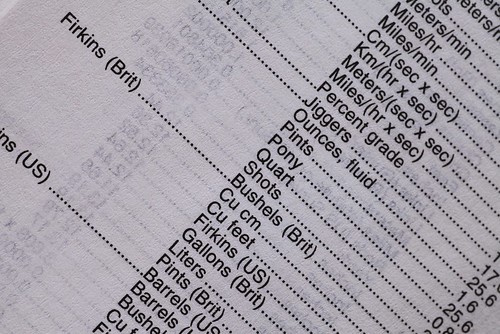 If someone in the New World wants to sell you a firkin of home-brew, you'll want to know just how much that is.
If someone in the New World wants to sell you a firkin of home-brew, you'll want to know just how much that is.
Available on Amazon—as long as Amazon still operates . . .
A proper camp breakfast
 GSI Pinnacle griddle on the Snow Peak large Pack and Carry Fireplace with bridge attachment.
GSI Pinnacle griddle on the Snow Peak large Pack and Carry Fireplace with bridge attachment.
Hickory-smoked bacon sizzles on a griddle. The fat pools, spreads, and infuses eggs scambling in butter nearby.
Did your salivary glands just twitch? Of course they did. Any vegans reading this—you had the same reaction. Oh, you might suppress it, pretend it didn’t happen, but somewhere deep down your atavistic omnivore is beseeching you to reject dietary self-flagellation and embrace your rightful place in the food chain.
We all know that eating bacon and eggs on a daily basis is probably not a wise habit—and besides, it wouldn’t be a treat then. But there’s no harm in indulging on a camping trip. Imagine: Dawn breaks over distant peaks, a breeze stirs pine trees overhead, blue jays greet the new day with a raucous chorus, and you stand over a fire with a cup of coffee, inhaling the scent of . . . frying tofu? C’mon.
To do bacon and eggs—and many other proper camping dishes—correctly it’s nice to have a griddle. At home we use cast iron, but that’s a bit heavy for a mobile kitchen when you consider its specialized niche. So we recently tried the Pinnacle Griddle from GSI Outdoors. It’s aluminum and just a bit over two pounds, yet offers a generous 10 by 18-inch cooking area surrounded by a grease moat. The surface is some non-stick space-age stuff—which we eschew at home but which is nice for cleaning up with a limited water supply. The back is hard-anodized (GSI offers a non-anodized version called the Bugaboo).
That one-and-a-quarter square foot size is perfect because, a) when we do eat bacon and eggs we eat a lot, and, b) because it fits nicely over our large Snow Peak Pack and Carry fireplace. (Snow Peak makes a cast iron griddle insert for their fireplace bridge, but it's ridged, and suitable only for cooking meat; we also use our griddle for pancakes and flatbreads.)
 The grease moat keeps excess grease off the main cooking area. On the Snow Peak fireplace bridge, you can carefully slide the griddle to the side and pour off excess into a container.
The grease moat keeps excess grease off the main cooking area. On the Snow Peak fireplace bridge, you can carefully slide the griddle to the side and pour off excess into a container.
Cooking over mesquite coals accomplishes two things. First, it adds to the atmosphere of the experience; second, it keeps that atmosphere out of the camper, where too much bacon grease and smoke too often would not be good for the canopy and upholstery. The griddle also fits in the fireplace’s (insanely obtuse) carrying case.
The Pinnacle Griddle’s aluminum is fairly thin, which means low heat will suffice, but not so thin that there were hotspots—it heated and cooked evenly for both bacon and pancakes. However, the surface of ours also came slightly convexly warped, so that an egg cracked in the middle would sort of elongate toward the edge until corraled with a spatula. I plan to see if it will flatten, using some heavy boards and judicious pressure.
 Cooking eggs and tortillas in the bacon grease. Can life get any better?
Cooking eggs and tortillas in the bacon grease. Can life get any better?
In the meantime, it’s working just fine—and we’ve successfully subverted several vegans at group camps.
Visit GSI here.
Hint: When using “Search,” if nothing comes up, reload the page, this usually works. Also, our “Comment” button is on strike thanks to Squarespace, which is proving to be difficult to use! Please email me with comments!
Overland Tech & Travel brings you in-depth overland equipment tests, reviews, news, travel tips, & stories from the best overlanding experts on the planet. Follow or subscribe (below) to keep up to date.
Have a question for Jonathan? Send him an email [click here].
SUBSCRIBE
CLICK HERE to subscribe to Jonathan’s email list; we send once or twice a month, usually Sunday morning for your weekend reading pleasure.
Overland Tech and Travel is curated by Jonathan Hanson, co-founder and former co-owner of the Overland Expo. Jonathan segued from a misspent youth almost directly into a misspent adulthood, cleverly sidestepping any chance of a normal career track or a secure retirement by becoming a freelance writer, working for Outside, National Geographic Adventure, and nearly two dozen other publications. He co-founded Overland Journal in 2007 and was its executive editor until 2011, when he left and sold his shares in the company. His travels encompass explorations on land and sea on six continents, by foot, bicycle, sea kayak, motorcycle, and four-wheel-drive vehicle. He has published a dozen books, several with his wife, Roseann Hanson, gaining several obscure non-cash awards along the way, and is the co-author of the fourth edition of Tom Sheppard's overlanding bible, the Vehicle-dependent Expedition Guide.



